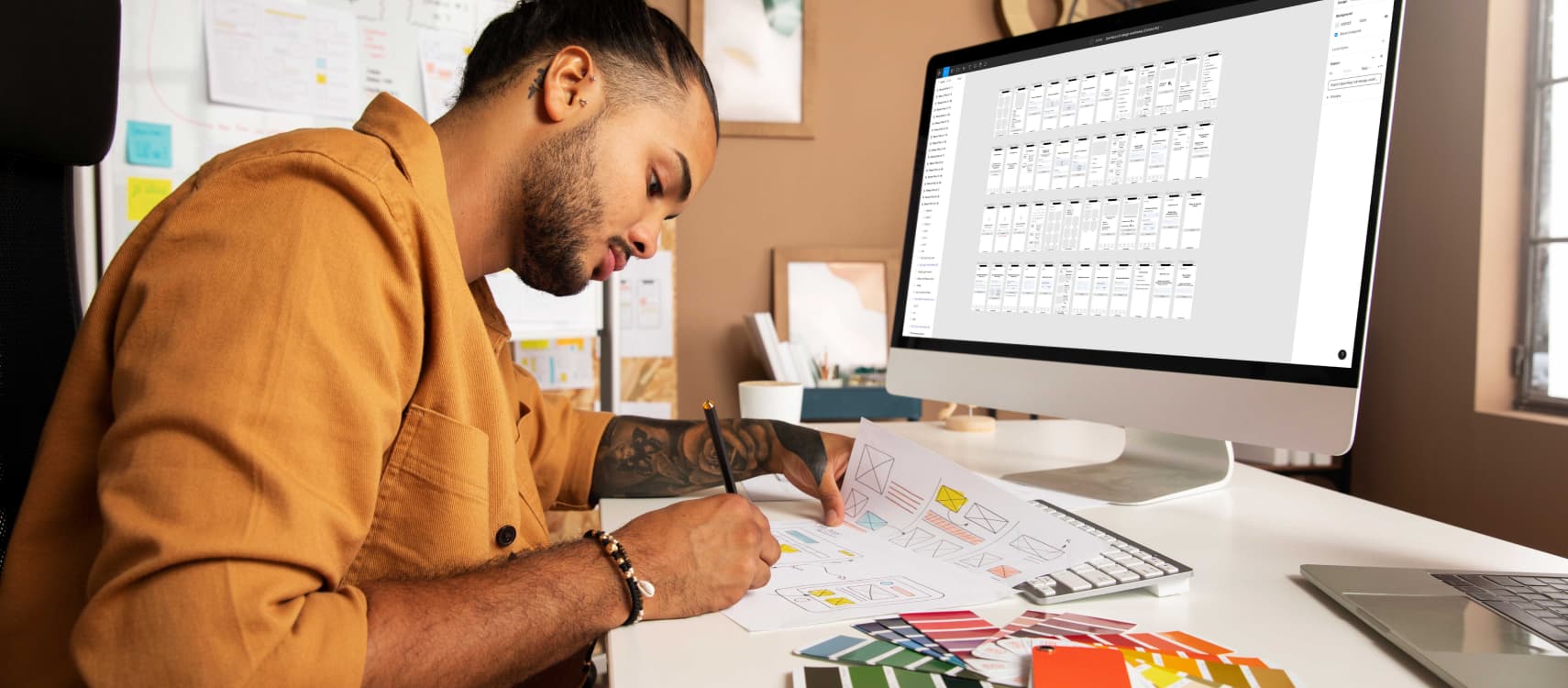Table of Contents
- Understanding UI and UX Designs
- Differentiation of UI and UX Designs
- Complementary Nature of UI and UX
- Consistency and Familiarity
- Role of Front-End Development
- UI Design Trends
- UX Design Trends
- Summarising
In the rapidly evolving world of technology and design, UI (User Interface) and UX (User Experience) have emerged as critical components for creating successful digital products and services. Both disciplines work hand in hand to enhance user satisfaction and drive engagement. A skilled UI/UX designer understands the importance of harmonizing these two aspects to deliver a seamless and delightful user experience.
Understanding UI and UX Designs
A UI Design service is primarily concerned with the visual presentation and layout of digital interfaces. It focuses on crafting visually appealing elements that are intuitive, consistent, and accessible. The primary goal of UI design is to ensure that users can interact effortlessly with a product or service. This includes creating eye-catching icons, buttons, typography, color schemes, and other graphical elements that evoke emotions and guide users through their journey.
On the other hand, a UX Design company deals with the overall experience a user has while interacting with a digital product or service. It aims to understand users’ needs, motivations, and pain points to create a smooth, efficient, and enjoyable journey. UX designers conduct research, develop user personas, create wireframes and prototypes, and perform usability testing to optimize the user experience.
Differentiation of UI and UX Designs
While UI and UX designs are closely related, they have distinct purposes and roles:
UI Design
-
Focus:
Emphasizes the look and feel of a digital interface, incorporating aesthetics and branding elements.
-
Elements:
Includes creating visually appealing graphics, icons, buttons, and layouts that align with the brand identity.
-
Examples:
A banking app’s visually appealing interface with sleek icons and a well-organized layout that encourages users to navigate seamlessly.
UX Design
-
Focus:
Concentrates on the overall user experience, emphasizing usability, efficiency, and satisfaction.
-
Elements:
Involves user research, information architecture, wireframing, prototyping, and usability testing.
-
Examples:
A travel website with an intuitive booking process, user-friendly navigation, and personalized recommendations based on user preferences.
Complementary Nature of UI and UX Designs
- UI and UX designs work together synergistically to create a compelling user experience.
Visual Appeal and User Satisfaction
The visual elements created by the UI designer play a crucial role in evoking positive emotions and engagement. For instance, a well-designed app with an aesthetically pleasing layout and captivating graphics can entice users to explore further. However, visual appeal alone is not sufficient; a seamless user experience is equally essential. This is where UX design steps in. Through extensive research and analysis, UX designers can identify pain points and design solutions that ensure a smooth and satisfactory user journey.
Consistency and Familiarity
-
Consistency and Familiarity
UI design promotes consistency throughout the interface. Consistent elements help users understand the system better, reducing cognitive load and making navigation more intuitive. When users encounter consistent icons, buttons, and color schemes, they can quickly grasp the purpose of various elements, leading to a smoother user experience. The UI designer ensures that the interface adheres to brand guidelines and remains consistent across all pages and interactions.
-
User-Centric Approach
A successful digital product or service places the user at its core. UI/UX design services delve deep into user preferences, behaviors, and pain points. UX designers collaborate with UI designers to create interfaces that cater to users’ needs and expectations. By understanding the target audience, the UI/UX designer can craft interfaces that resonate with users, resulting in higher engagement and satisfaction.
-
Prototype Validation
During the design process, UX designers create wireframes and prototypes to test and validate proposed solutions. These prototypes act as a bridge between the concept and the final design. After user testing, valuable feedback is obtained. The UI designer then enhances the visual elements, ensuring they align with users’ preferences and expectations.
Role of Front-End Development Services
Front-end development services are instrumental in translating finalized UI/UX designs into functional and interactive digital products. Front-end developers bridge the gap between design and implementation, bringing the visual elements to life while ensuring responsiveness across different devices and platforms.
- Front-end developers work closely with UI/UX designers to understand the intricacies of the designs and the intended user interactions.
- With the proliferation of various devices, responsive design has become a necessity.
- Interactive elements and animations enhance user engagement and make the user experience more enjoyable.
UI Design Trends
-
Dark Mode Dominance
Dark mode offers a sleek and modern appearance with dark backgrounds and contrasting elements.
-
Neumorphism
Neumorphism blends skeuomorphism and flat design, creating interfaces with soft shadows and subtle 3D effects.
-
Minimalism and Simplification
Minimalism emphasizes clean and clutter-free interfaces that focus on essential content and functionality.
-
Microinteractions
Microinteractions provide subtle animations or feedback in response to user actions, making interfaces more engaging.
-
Asymmetric Layouts
Asymmetric layouts break away from traditional grid-based designs, creating unique and dynamic compositions.
UX Design Trends
-
Personalization and AI-driven Experiences
AI and machine learning enable personalized user experiences based on behavior and preferences.
-
Voice User Interfaces (VUIs)
Voice technology is growing, with UX designers focusing on natural and conversational voice-first experiences.
-
Augmented Reality (AR) and Virtual Reality (VR)
AR and VR are transforming UX design by offering immersive and interactive experiences.
-
Microinteractions for Enhanced Feedback
Microinteractions improve both UI and UX by making interactions smoother and more intuitive.
Inclusive Design and Accessibility
Inclusive design ensures that digital products and services are accessible to all users, regardless of disabilities or limitations.
Summarising
As technology and user expectations continue to evolve, UI and UX design trends will remain dynamic and ever-changing. Keeping abreast of these trends and incorporating them thoughtfully into design strategies can lead to more successful and engaging digital products and services. Embracing innovation, personalization, and user-centricity will be essential for designers to create exceptional digital experiences in the future.










